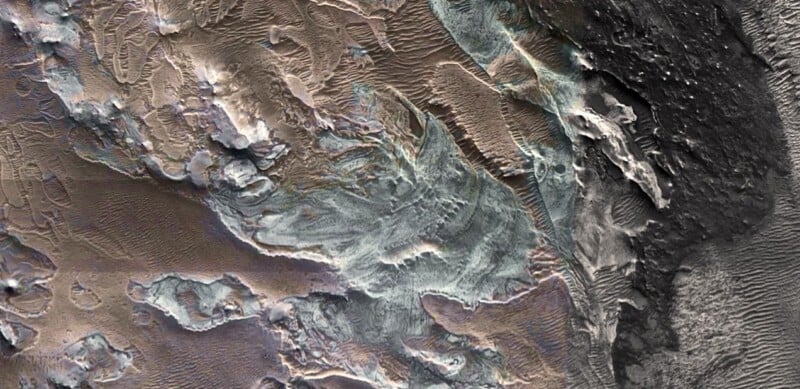
The stays of a glacier on Mars have been found through the HiRISE digital camera connected to the Mars Reconnaissance Orbiter. If the ice is confirmed, it could have important implications for people who could land there sooner or later.
The SETI Institute made the announcement on Wednesday. It launched the picture that options light-toned deposits consisting of sulfate salts, crevasse fields, and moraine bands which can be indicators of a “relict glacier.”
The glacier is estimated to be roughly 4 miles large (six kilometerfs) and a couple of.5 miles lengthy (4 kilometers). The researchers hope that the invention implies that the planet was as soon as extra watery than beforehand thought.
“What we’ve discovered isn’t ice, however a salt deposit with the detailed morphologic options of a glacier,” says Dr. Pascal Lee, a planetary scientist with the SETI Institute and the Mars Institute, and the lead creator of the research.
“What we predict occurred right here is that salt shaped on prime of a glacier whereas preserving the form of the ice under, all the way down to particulars like crevasse fields and moraine bands.”

Volcanic Area
The realm of Mars the place the traditional glacier was noticed has a historical past of volcanic exercise. When mixtures of volcanic ash and lava react with water, a tough, crusty salt layer can type.
“The place a few of the volcanic supplies got here in touch with glacier ice, chemical reactions would have taken place on the boundary between the 2 to type a hardened layer of sulfate salts,” says research co-author Sourabh Shubham, a doctoral pupil of geology on the College of Maryland, Faculty Park.
“That is the almost definitely clarification for the hydrated and hydroxylated sulfates we observe on this light-toned deposit.”
Over time, erosion could have eliminated the volcanic supplies, and a crusty layer of sulfates mirroring the glacier ice beneath grew to become uncovered, which might clarify how a salt deposit is now seen.
“Glaciers usually current distinctive kinds of options, together with marginal, splaying, and tic-tac-toe crevasse fields, and in addition thrust moraine bands and foliation. We’re seeing analogous options on this light-toned deposit, in type, location, and scale. It’s very intriguing,” says John Schutt, a geologist on the Mars Institute, skilled icefield information within the Arctic and Antarctica, and a co-author of the research.
Whether or not ice is preserved beneath the light-toned deposits stays to be seen however the research attracts comparisons with the salt lakebeds of the Altiplano in South America the place previous glacier ice has remained protected beneath blankets of salts.
Water on Mars can be a game-changer for human exploration of the planet.
“The need to land people at a location the place they may have the ability to extract water ice from the bottom has been pushing mission planners to think about greater latitude websites,” provides Lee.
“However the latter environments are sometimes colder and more difficult for people and robots. If there have been equatorial places the place ice is perhaps discovered at shallow depth, then we’d have one of the best of each environments: hotter circumstances for human exploration and nonetheless entry to ice.”
Supply By https://petapixel.com/2023/03/17/image-of-ancient-glacier-on-mars-raises-hopes-for-human-exploration/